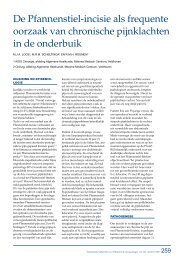Surgical management of chronic inguinal pain syndromes - Liespijn
Surgical management of chronic inguinal pain syndromes - Liespijn
Surgical management of chronic inguinal pain syndromes - Liespijn
You also want an ePaper? Increase the reach of your titles
YUMPU automatically turns print PDFs into web optimized ePapers that Google loves.
Overall 26 male patients (20.1 per cent) reported a bothersome or even invalidatingsensation during or after ejaculation, which was frequently described as ‘burning’ or‘stabbing’. One patient mentioned a worrisome feeling <strong>of</strong> mechanical obstruction duringejaculation. Most <strong>of</strong> these patients (16/26) had neuropathic <strong>pain</strong> complaints as well.Eighteen men complained <strong>of</strong> increasing <strong>inguinal</strong> <strong>pain</strong> during an erection. Testicular <strong>pain</strong>was mentioned by 17 patients. Not all patients with testicular <strong>pain</strong> had ejaculatorycomplaints, or a <strong>pain</strong>ful erection. A direct postoperative onset <strong>of</strong> impotence was mentionedby three patients.QuestionnairePatients eligiblefor questionnaire(n=2164)Response rate: 82%(n=1766)Patients with elective hernia repair (n=2339)Excluded:- Deceased (n=82)- Unobtainable address (n=75)- Mentally incapacitated (n=18)Inclusion criteria:Pain intensity: moderate or severe(VAS ≥ 3)Physical examinationFindings on physical examination are listed in table 3. Inspection revealed bulges in 8.8per cent <strong>of</strong> patients. Palpation unveiled a distinct trigger point in or around the scar inthe majority <strong>of</strong> patients (46.6 per cent). Moreover, the pubic tubercle was <strong>pain</strong>ful in 12.2per cent <strong>of</strong> patients. Neurophysiologic abnormalities were frequently observed.Hypoesthesia was diagnosed in 95 patients, whereas hyperesthesia was present ineleven cases. No patient showed signs <strong>of</strong> allodynia.Proposed classificationGroup I: Neuropathic <strong>pain</strong>A classification including different causes <strong>of</strong> <strong>pain</strong> is provided in table 4. Pain was judgedneuropathic in nearly half <strong>of</strong> the patients (n=72, 46.5 per cent). They all complained <strong>of</strong>an activity-induced sharp <strong>pain</strong> combined with a trigger point and signs <strong>of</strong> a neurophysiologicdisequilibrium. Eleven patients showed hyperesthesia. All patients were <strong>of</strong>fereda peripheral nerve block with 10 cc lidocain, and 51 patients agreed with this nerve block.The remainder <strong>of</strong> the group did not value their <strong>pain</strong> serious enough (n = 14), had previouslyreceived a successful nerve block (n = 2), showed contra-indications (e.g. bleedingdisorders, n = 2), or were scared <strong>of</strong> needles (n = 3). Eighty percent <strong>of</strong> all patients receivinga local block (n=41) reported <strong>pain</strong> relief (VAS-scores > 50 per cent lower). Pain relief wasInvitation for outpatient departmentEligible (n=211)History,physical examination(n=148)Reasons not to participate:- Recent <strong>pain</strong> reduction (n=27)- No current tel. no/ address (n=18)- Did not show up (n=8)- Work obligations (n=5)- Alternative treatment n=3)- Lack <strong>of</strong> interest (n=2)n (%)Mean age - Yr [range] 40 [22-69]Sex ratio male/female 129/19 (87.2/ 12.8)<strong>Surgical</strong> techniqueLichtenstein 103 (69.6)Shouldice 10 (6.8)TEP* 19 (12.8)TAPP 16 (10.8)Surgery for recurrent hernia 38 (25.7)Bilateral hernia repair 32 (21.6)Median follow up - Months [range] 46 [3-300]Figure 1 Flow chart <strong>of</strong> identified <strong>pain</strong> patients following an elective <strong>inguinal</strong> hernia repair .Table 1 Demographic and operative characteristics <strong>of</strong> patients with <strong>chronic</strong> postherniorrhaphy <strong>pain</strong> who visitedthe outpatient department (n=148). Values between parentheses are percentages, unless otherwise specified.*TEP = Total Extra Peritoneal, TAPP = Trans Abdominal Pre Peritoneal.68 Chapter 5Classifying postherniorrhaphy <strong>pain</strong> <strong>syndromes</strong> following elective groin hernia repair 69





